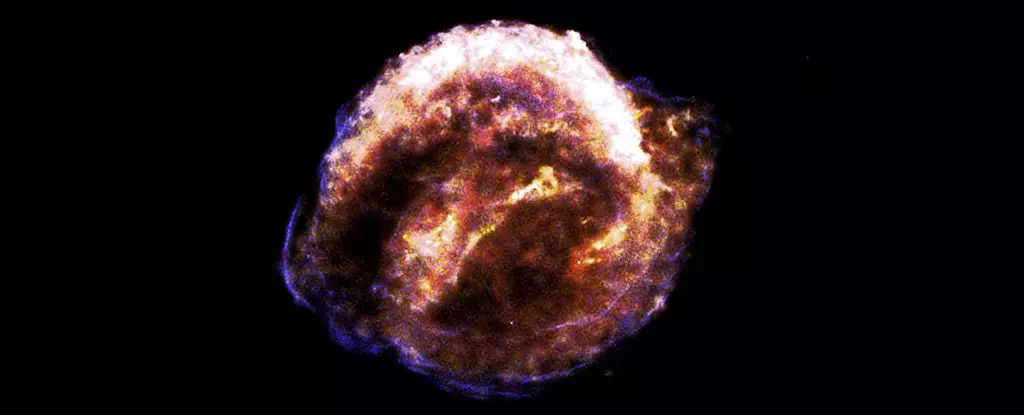Our understanding of the cosmos has long been rendered through the lens of profound events that unfold in the universe, particularly the explosive death of massive stars known as supernovae. These dramatic cosmic incidents do more than simply signal the end of a star’s life; they contribute to the creation of heavy elements essential for life on Earth. Among these elements is iron, and recent studies have traced two distinct deposits of the iron isotope Fe60 in seafloor sediments back to the aftermath of supernova explosions that occurred between two to six million years ago. As research illuminates how these stellar phenomena bombard Earth with cosmic radiation, it raises essential questions regarding their environmental and biological implications.
Through the explosive force of supernovae, remarkable quantities of energy and radiation are cast into space, resulting in both immediate and long-term effects on celestial bodies, including Earth. A leading study published in the *Astrophysical Journal Letters,* spearheaded by Caitlyn Nojiri of UC Santa Cruz, delves into the notable increase in cosmic radiation resulting from nearby supernova events. The capacity for these explosions to enhance radiation levels on Earth by several orders of magnitude could have significant consequences, potentially driving evolutionary changes among living organisms.
The study posits that cosmic radiation continually envelops us, fluctuating based on our Solar System’s position within the Milky Way galaxy. While terrestrial radiation accumulates and diminishes over billions of years, cosmic radiation remains a persistent feature of our environment. This difference creates a constant interplay that might have influenced the evolutionary path of life on Earth, as the authors emphasize the significance of supernova activity in altering the cosmic radiation landscape.
Earth resides within a colossal structure in space known as the Local Bubble, a region created by the explosive remnants of multiple supernovae. This bubble spans nearly 1,000 light-years and reveals the history of numerous supernova explosions over the past fifteen million years. The authors of the paper note that at least nine supernovae have detonated in the vicinity of the Local Bubble over a six-million-year timeframe.
The younger deposits of Fe60 from two to three million years ago indicate a more recent supernova explosion, very likely originating from stellar groups like the Upper Centaurus Lupus or the Tucana Horologium associations. Meanwhile, the older Fe60 accumulation can be traced back to Earth’s entry into the Local Bubble. These findings imply an intriguing interconnectivity between stellar phenomena and Earth’s geological and biological histories.
One profound area explored in this research is the biological effects of increased cosmic radiation spurred by supernova events. As suggested, a higher dosage of radiation could lead to severe DNA damage, manifesting as double-strand breaks that significantly alter chromosomal structures. These disruptions in genetic material could otherwise pave the way for mutations, which may boost species diversification.
Interestingly, a recent study noted an acceleration in virus diversification around the time of increased cosmic radiation exposure, which prompts contemplations about the potential links between radiation levels and evolutionary dynamics. The study raises a compelling possibility: could supernova radiation have acted as a catalyst for biodiversity during critical junctures in Earth’s history?
While it is established that supernova radiation was unlikely to precipitate mass extinctions, it could still affect the mutation rates necessary for species to adapt and evolve amid environmental changes. The question remains whether cosmic radiation represents an advantageous or detrimental force in the grand scheme of evolutionary progress.
Despite the compelling narratives woven by these cosmic events, the research underscores a profound truth: our comprehension of the direct effects of cosmic radiation on biological systems is still underdeveloped. The study of radiation, particularly muons, which dominate ground-level cosmic rays, remains largely unexplored. Thus, a deeper understanding is paramount for clarifying how cosmic radiation might have influenced life on our planet.
The cosmic environment perpetually influences life on Earth in both visible and unseen ways. With each passing moment, distant supernovae continue to shape the evolutionary landscape of our biosphere, revealing a tapestry woven from the fundamental interactions between celestial phenomena and earthly existence. It is within this intricate web that we are reminded of our indelible connection to the universe, where supernovae may have played an essential role in the evolutionary chain that led to our presence on Earth today. Without these stellar explosions, the course of life may have looked profoundly different.


Leave a Reply